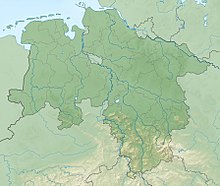Long mountain from Langen
Coordinates: 53 ° 36 ′ 13 ″ N , 8 ° 36 ′ 5 ″ E
The Lange Berg von Langen is originally a 90.0 m long dam-like burial mound on the crest of a natural bump. It is located northeast of the train station in Langen in Geestland in the Elbe-Weser triangle in the district of Cuxhaven in Lower Saxony and is a type of prehistoric monument that is rare in its kind.
The hill is an average of 2.5 m high and about 22.0 m wide. The hill, which consists of around 5,000 m³ of earth, was shortened by 8.0 m to around 82.0 m today as the road was built. The artificial origin of the elevation was recognized centuries ago, but the meaning could not be explained.
This grave form from the older Bronze Age only occurs in the Elbe-Weser triangle in the Feldmark Debstedt , which belongs to Langen, and is two kilometers away . The "Lange Berg von Debstedt" has a length of about 85.0 m. Before the erosion, at both ends, it will have been around 100 m long. Both long hills belong to a chain of burial mounds along old path connections. While only a spot remained in the field of a burial mound immediately south of the Lange Berg, a 1.20 m high mound with a diameter of about 10 m remained to the north. A few kilometers away is a group of around 130 hills near Drangstedt .
In 1909, Paul Schübeler, who together with Carl Schuchhardt (1859–1943) had laid test cuts in the Long Mountain, partially excavated the system. Although he only examined about a quarter of the hill, he found the two main graves. Just below the surface, he came across 32 urns of the Jastorf type with remains of bronze and iron fibula and iron needles . These finds were made in the pre-Roman Iron Age around 400 BC. Classified. They came to the hill at a time when the Long Mountain was over 1,000 years old.
As the oldest finds show, the construction of the hill made of plagues began in the older Bronze Age. At first there were probably two round mounds that were later connected. In the north and south there were two areas surrounded by stone wreaths, inside and outside of which upper and lower graves were found. In the north hill there is a central burial and four body graves, in the south hill there is a central burial and another grave. Some contained weapons and jewelry , others had no gifts. At least one grave was a woman's burial. The finds were lost in 1947 in the fire at the Marschenhaus open-air museum in Bremerhaven . However, Schübeler's report contains photos of some of the finds. Another part is documented by pencil sketches made by Kurt Tackenberg in 1931 .
The finds from the Langen Berg near Langen include heel axes , daggers , wheel needles and various pieces of jewelry . According to the finds, the construction phases of the Long Mountain all fall into period II according to Montelius , but the oldest part could also come from period I.
Nearby is the large stone grave Langen (Geestland)
literature
- Joseph Bergmann: The older Bronze Age of Northwest Germany. New methods for the ethnic and historical interpretation of prehistoric sources Elwert Verlag, Marburg 1970, ISBN 3-7708-0404-X . (Kassel contributions to prehistory and early history; Vol. 2) ( Grave and hoard finds , Die Formen .)
- Willi Wegewitz : The graves of the Stone and Bronze Age in the area of the Lower Elbe. The districts of Stade and Harburg (publications of the Prehistoric Collection of the State Museum Hanover; Volume 11). Lax Verlag, Hildesheim 1949.
- Almost forgotten tumulus, local historian Hermann Westedt explains the history of the "Long Mountain" - wheel needle found , in: Nordsee-Zeitung of July 3, 2015, p. 21
